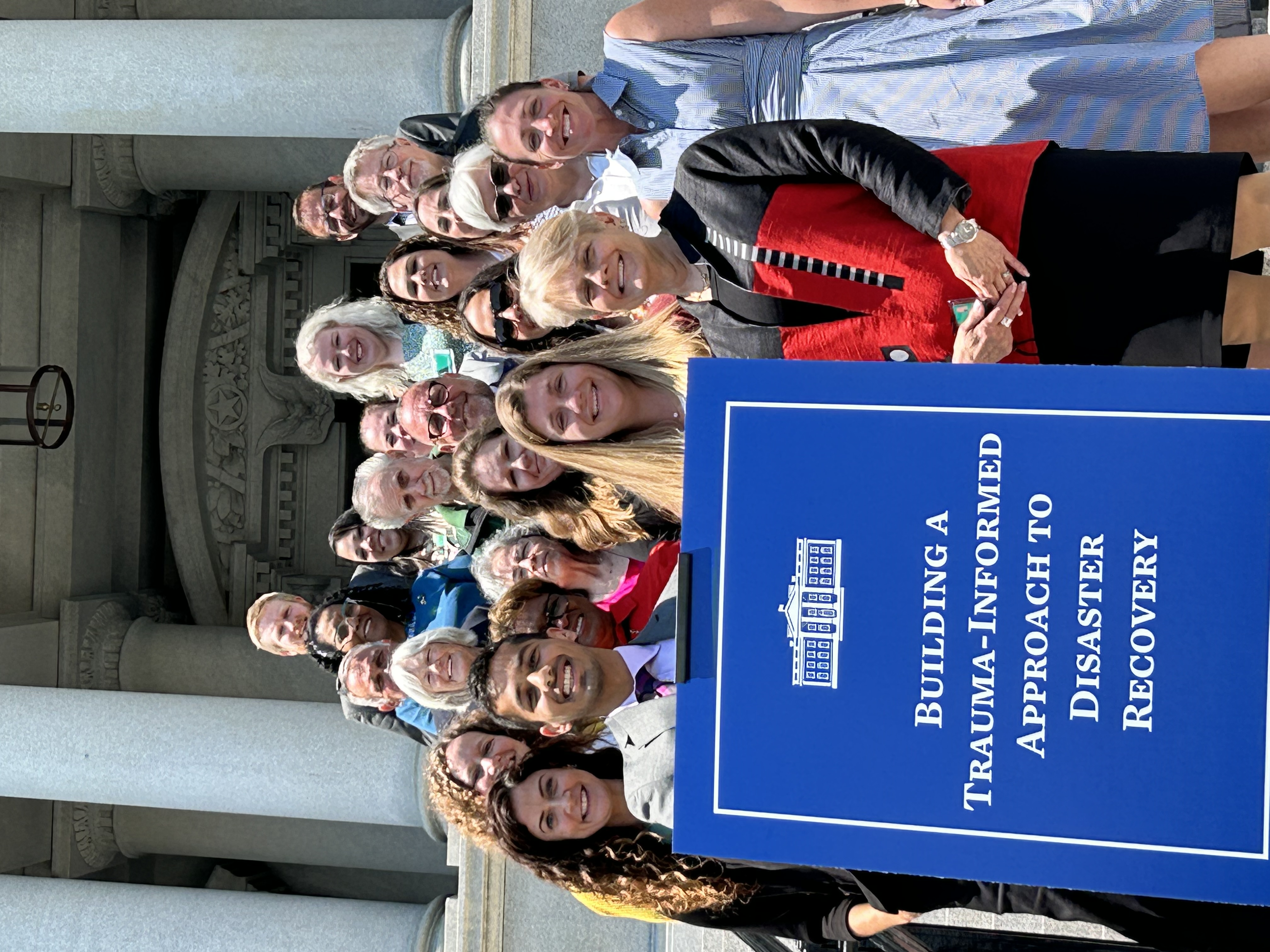The Executive Order on Transforming Federal Customer Experience and Service Delivery to Rebuild Trust In Government directs a whole-of-government approach to improve service delivery for persons during critical moments or Life Experiences. This blog highlights the work of the Recovering from a Disaster Life Experience team to address the overwhelm and trauma experienced by survivors and employees in disaster response.
Rebuilding More Than Structures: Addressing Trauma in Disaster Recovery
In 2023, the U.S. faced hundreds of natural disasters resulting in $92.9 billion in damages, including 28 separate billion-dollar disasters. But these numbers are only part of the story. Natural disasters leave more than physical destruction in their wake. Survivors are left with profound grief, worry, and fear as they reckon with the displacement of their families and communities.
Those impacted by a disaster struggle to comprehend the enormity of what has been lost: the tangible resources of food, shelter, and power, and the intangible sense of psychological safety. For survivors seeking federal assistance with the former, it is easy to become overwhelmed by forms demanding precise information, processes with seemingly impossible-to-meet deadlines, and ever-shifting eligibility requirements. The system meant to help them can feel cold and confusing –a maze of bureaucracy that seems indifferent to their newfound reality. Survivors describe the assistance process as an uphill battle, where paperwork and portals add to burden and trauma, rather than alleviating it.
For federal responders, the experience is no less complex. Tasked with helping communities in crisis through a system designed for efficiency rather than empathy, they are not immune to emotional impact. They confront the devastating aftermath of disasters, listen to stories of loss, and witness the struggles of the people they serve, which linger long after responders leave the affected areas. As the window between disasters has shortened, from 82 days in the 1980s to an average of 18 days now, repeated exposure leads to secondary traumatic stress—a cumulative emotional toll that results in fatigue, emotional detachment, and reduced ability to connect, empathize, and support others effectively.
How do we address the trauma experienced by survivors and the responders meant to help them?
How can we redesign a recovery process that moves beyond the minutiae of government requirements to ensure people feel supported?
These questions are central to reimagining disaster recovery—not just as an exercise in logistics, but as a deeply human endeavor that cares for everyone involved.
A New Approach: Building Trauma-Informed Disaster Recovery
Understanding these challenges, the Biden-Harris administration set out in 2022 to reimagine disaster response to attend to the emotional and psychological well-being of survivors, as well as their logistical needs. Under the Life Experiences initiative, a cross-agency Recovering from a Disaster team conducted interviews with over 80 survivors, federal and local government responders, and staff at non-governmental organizations. From these conversations, two needs emerged: administering support for survivors beyond resources and equipping responders with tools to improve their own well-being.
To address both needs, the team proposed training responders in trauma-informed care, so they could recognize and mitigate the impacts of survivor and secondary trauma.
Resources Built By, For, and With Federal Staff
To create a trauma-informed training model and approach to disaster recovery, the team prioritized designing with and for federal staff from the Department of Health and Human Services, the Federal Emergency Management Agency (FEMA), the Small Business Administration (SBA), and the Office of Personnel Management. Incorporating extensive input from responders and utilizing iterative design methods, the team built a training around three core modules:
- Understanding Trauma and Its Impact: Helping federal staff recognize the various forms of trauma—whether from the disaster itself or previous experiences—that survivors may bring into interactions with government. This module also addresses how responders might experience trauma themselves, emphasizing the importance of awareness.
- Applying Trauma-Informed Techniques: This module introduces practical skills for improving interactions with survivors—techniques like listening without judgment, building trust, and creating a sense of safety. The goal is to reduce the possibility of survivors feeling overwhelmed by impersonal processes and to minimize re-traumatization, the inadvertent triggering of memories associated with the initial trauma.
- Taking Care When Disaster Strikes: Recognizing that disaster response can lead to secondary traumatic stress, this module focuses on equipping responders with tools for self-care, stress management, and seeking support. It underscores that a trauma-informed approach is not just about treating survivors—it also means creating a supportive environment for federal staff.
The modules were designed to be delivered through in-person workshops, with readily available online resources to supplement training and help staff integrate practices into their daily work. See the guidebook and explanatory videos on Performance.gov.
From Pilot to Progress: Real Change on the Ground
In 2023, the trainings were piloted in FEMA’s Region 2 New York and Puerto Rico offices. Initial feedback was overwhelmingly positive, with responders sharing how the workshop helped them reframe their role from paperwork processers and supply distributors to partners in recovery working to restore stability and dignity for survivors.
“I have a deep appreciation for the discussions we had in class. I got to hear about other experiences, and I was exposed to new ideas which I could have not experienced from just listening to a lecture training.”
“I have been deployed in a supporting role, and I have learned to navigate my own trauma, change, and need to communicate what is going on while reaching out to others to make sure they are well taken care of as well.”
Seeing the success of the pilot, agency leaders like FEMA Administrator Deanne Criswell, championed the expansion of workshops to other regional offices in Texas and Oklahoma, and to the SBA Office of Disaster Recovery and Resilience.
The team has also sought out opportunities to strengthen the availability and applicability of the training. In June 2024, the team convened disaster response officials from state governments and leaders from relief non-profits to take the training and provide feedback. Noting that many of the principles and practices can extend beyond the disaster space, the team administered and adapted the training for staff from the Department of Justice Community Relations Service, who support communities after incidents of civil unrest.
Expanding trauma-informed practices represents a larger vision of instilling a unified federal approach to trauma, response, and recovery.

What Comes Next: The Road to Lasting Change
The journey towards a trauma-informed federal response is ongoing. True transformation will take time, requiring cultural shifts, continuous training, and continuous engagement with those directly impacted by disasters and traumatic events. To support agencies in adopting the model, the team is developing an implementation guidebook for agency leaders and a train-the-trainers manual.
Looking ahead to 2025, the goal is to move beyond the pilot phase, and work with FEMA, SBA, and other federal agencies to deeply embed trauma-informed practices. The team will continue developing and deploying trauma-informed communications and strategies at Disaster Recovery Centers at the site of impact.
Challenges persist, but so does the commitment to a future where every disaster survivor feels understood, where every responder is equipped to provide meaningful care, and where the government’s role in recovery is not only effective but profoundly human.
Want to Learn More?
To learn more about building a trauma-informed care approach, consult the guidebook and videos.
To learn more about Recovering from a Disaster Life Experience efforts, check out the team’s March 2024 webinar, or visit the Recovering from a Disaster Life Experience outputs page.




